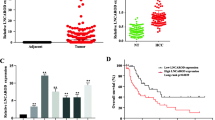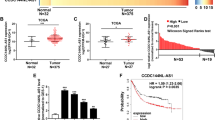Abstract
Long non-coding RNA (lncRNA) has been demonstrated as vital regulator in human cancer. However, the precise role of lnc-TDRG1 in cervical cancer (CC) remains unclear, so this study was aimed to clarify the role and underlying molecular mechanism of lnc-TDRG1 in CC. The real-time quantitative polymerase chain reaction (RT-qPCR) was conducted to assess the expression levels of lnc-TDRG1, miR-214-5p and Semaphorin 4C (SEMA4C). Under hypoxia condition, the biological behaviors of CC cell, including invasion and glycolysis were determined by transwell assay and Glucose Assay Kit and Lactate Assay Kit, respectively. The Western blot assay was employed to test the expression level of SEMA4C and hexokinase 2 (HK2) expression. The interaction relationship between miR-214-5p and lnc-TDRG1 or SEMA4C was analyzed bioinformatics database and confirmed by dual-luciferase reporter assay, respectively. A xenograft experiment in nude mice was established to clarify the functional role of lnc-TDRG1 in vivo. We found Lnc-TDRG1 was highly expressed in CC tissues and cells and it was upregulated in response to hypoxia. Loss-of-functional experiment suggested that knockdown of lnc-TDRG1 impede invasion, hypoxia-induced glycolysis in vitro and tumor growth in vivo, which was abolished by knockdown of miR-214-5p or overexpression of SEMA4C. Moreover, we confirmed that miR-214-5p specifically bound to SEMA4C and negatively correlated with SEMA4C expression. Collectively, lnc-TDRG1 regulated SEMA4C expression by sponging miR-214-5p in CC. Collectively, mechanistically, lnc-TDRG1 could act as a sponge of miR-214-5p to regulate the expression of SEMA4C, and further regulate invasion and hypoxia-glycolysis in CC cells.







Similar content being viewed by others
Availability of data and materials
The analyzed data sets generated during the present study are available from the corresponding author on reasonable request.
References
Ambros V (2004) The functions of animal microRNAs. Nature 431:350–355. https://doi.org/10.1038/nature02871
Bray F, Ferlay J, Soerjomataram I, Siegel RL, Torre LA, Jemal A (2018) Global cancer statistics 2018: GLOBOCAN estimates of incidence and mortality worldwide for 36 cancers in 185 countries. CA Cancer J Clin 68:394–424. https://doi.org/10.3322/caac.21492
Chang YN, Zhang K, Hu ZM, Qi HX, Shi ZM, Han XH, Han YW, Hong W (2016) Hypoxia-regulated lncRNAs in cancer. Gene 575:1–8. https://doi.org/10.1016/j.gene.2015.08.049
Chen H, Sun J, He Y, Zou Q, Wu Q, Tang Y (2015) Expression and localization of testis developmental related gene 1 (TDRG1) in human spermatozoa. Tohoku J Exp Med 235:103–109. https://doi.org/10.1620/tjem.235.103
Chen S, Wang L-L, Sun K-X, Xiu Y-L, Zong Z-H, Chen X, Zhao Y (2018a) The role of the long non-coding RNA TDRG1 in epithelial ovarian carcinoma tumorigenesis and progression through miR-93/RhoC pathway. Mol Carcinog 57:225–234. https://doi.org/10.1002/mc.22749
Chen S, Wang LL, Sun KX, Liu Y, Guan X, Zong ZH, Zhao Y (2018b) LncRNA TDRG1 enhances tumorigenicity in endometrial carcinoma by binding and targeting VEGF-A protein. Biochim Biophys Acta Mol Basis Dis 1864:3013–3021. https://doi.org/10.1016/j.bbadis.2018.06.013
Duenas-Gonzalez A, Campbell S (2016) Global strategies for the treatment of early-stage and advanced cervical cancer. Curr Opin Obstet Gynecol 28:11–17. https://doi.org/10.1097/GCO.0000000000000234
Eales KL, Hollinshead KER, Tennant DA (2016) Hypoxia and metabolic adaptation of cancer cells. Oncogenesis 5:e190–e190. https://doi.org/10.1038/oncsis.2015.50
Fu Z, Chen C, Zhou Q, Wang Y, Zhao Y, Zhao X, Li W, Zheng S, Ye H, Wang L, He Z, Lin Q, Li Z, Chen R (2017) LncRNA HOTTIP modulates cancer stem cell properties in human pancreatic cancer by regulating HOXA9. Cancer Lett 410:68–81. https://doi.org/10.1016/j.canlet.2017.09.019
Fyles A, Milosevic M, Hedley D, Pintilie M, Levin W, Manchul L, Hill RP (2002) Tumor hypoxia has independent predictor impact only in patients with node-negative cervix cancer. J Clin Oncol 20:680–687. https://doi.org/10.1200/JCO.2002.20.3.680
Geisler S, Coller J (2013) RNA in unexpected places: long non-coding RNA functions in diverse cellular contexts. Nat Rev Mol Cell Biol 14:699–712. https://doi.org/10.1038/nrm3679
Jiang X, Li D, Yang J, Wen J, Chen H, Xiao X, Dai Y, Yang J, Tang Y (2011) Characterization of a novel human testis-specific gene: testis developmental related gene 1 (TDRG1). Tohoku J Exp Med 225:311–318. https://doi.org/10.1620/tjem.225.311
Jiang H, Liang M, Jiang Y, Zhang T, Mo K, Su S, Wang A, Zhu Y, Huang G, Zhou R (2019) The lncRNA TDRG1 promotes cell proliferation, migration and invasion by targeting miR-326 to regulate MAPK1 expression in cervical cancer. Cancer Cell Int 19:152. https://doi.org/10.1186/s12935-019-0872-4
Lahue BJ, Baginska E, Li SS, Parisi M (2015) Health technology assessment on cervical cancer screening, 2000–2014. Int J Technol Assess Health Care 31:171–180. https://doi.org/10.1017/S0266462315000197
Liu M, Liu L, Bai M, Zhang L, Ma F, Yang X, Sun S (2018) Hypoxia-induced activation of Twist/miR-214/E-cadherin axis promotes renal tubular epithelial cell mesenchymal transition and renal fibrosis. Biochem Biophys Res Commun 495:2324–2330. https://doi.org/10.1016/j.bbrc.2017.12.130
Marchiq I, Pouyssegur J (2016) Hypoxia, cancer metabolism and the therapeutic benefit of targeting lactate/H(+) symporters. J Mol Med (Berl) 94:155–171. https://doi.org/10.1007/s00109-015-1307-x
Naderi A, Teschendorff AE, Barbosa-Morais NL, Pinder SE, Green AR, Powe DG, Robertson JF, Aparicio S, Ellis IO, Brenton JD, Caldas C (2007) A gene-expression signature to predict survival in breast cancer across independent data sets. Oncogene 26:1507–1516. https://doi.org/10.1038/sj.onc.1209920
Pang J, Li Z, Wang G, Li N, Gao Y, Wang S (2018) miR-214-5p targets KLF5 and suppresses proliferation of human hepatocellular carcinoma cells. J Cell Biochem. https://doi.org/10.1002/jcb.27498
Qiang R, Wang F, Shi LY, Liu M, Chen S, Wan HY, Li YX, Li X, Gao SY, Sun BC, Tang H (2011) Plexin-B1 is a target of miR-214 in cervical cancer and promotes the growth and invasion of HeLa cells. Int J Biochem Cell Biol 43:632–641. https://doi.org/10.1016/j.biocel.2011.01.002
Salmena L, Poliseno L, Tay Y, Kats L, Pandolfi PP (2011) A ceRNA hypothesis: the Rosetta Stone of a hidden RNA language? Cell 146:353–358. https://doi.org/10.1016/j.cell.2011.07.014
Song J, Li Y (2017) miR-25-3p reverses epithelial-mesenchymal transition via targeting Sema4C in cisplatin-resistance cervical cancer cells. Cancer Sci 108:23–31. https://doi.org/10.1111/cas.13104
Teng Y, Ding M, Wang X, Li H, Guo Q, Yan J, Gao L (2019) LncRNA RMRP accelerates hypoxia-induced injury by targeting miR-214-5p in H9c2 cells. J Pharmacol Sci. https://doi.org/10.1016/j.jphs.2019.07.014
Wei JC, Yang J, Liu D, Wu MF, Qiao L, Wang JN, Ma QF, Zeng Z, Ye SM, Guo ES, Jiang XF, You LY, Chen Y, Zhou L, Huang XY, Zhu T, Meng L, Zhou JF, Feng ZH, Ma D, Gao QL (2017) Tumor-associated lymphatic endothelial cells promote lymphatic metastasis by highly expressing and secreting SEMA4C. Clin Cancer Res 23:214–224. https://doi.org/10.1158/1078-0432.CCR-16-0741
Xie C, Zhang LZ, Chen ZL, Zhong WJ, Fang JH, Zhu Y, Xiao MH, Guo ZW, Zhao N, He X, Zhuang SM (2019) A novel hMTR4-PDIA3P1-miR-125/124-TRAF6 regulatory axis and its function in NF-K B signaling and chemoresistance. Hepatology. https://doi.org/10.1002/hep.30931
Xu M, Chen X, Lin K, Zeng K, Liu X, Pan B, Xu X, Xu T, Hu X, Sun L, He B, Pan Y, Sun H, Wang S (2018) The long noncoding RNA SNHG1 regulates colorectal cancer cell growth through interactions with EZH2 and miR-154-5p. Mol Cancer 17:141. https://doi.org/10.1186/s12943-018-0894-x
Yang Z, Chen S, Luan X, Li Y, Liu M, Li X, Liu T, Tang H (2009) MicroRNA-214 is aberrantly expressed in cervical cancers and inhibits the growth of HeLa cells. IUBMB Life 61:1075–1082. https://doi.org/10.1002/iub.252
Yang Q, Wang Y, Lu X, Zhao Z, Zhu L, Chen S, Wu Q, Chen C, Wang Z (2015) MiR-125b regulates epithelial-mesenchymal transition via targeting Sema4C in paclitaxel-resistant breast cancer cells. Oncotarget 6:3268–3279. https://doi.org/10.18632/oncotarget.3065
Zhang M, Wang D, Zhu T, Yin R (2017) miR-214-5p targets ROCK1 and suppresses proliferation and invasion of human osteosarcoma cells. Oncol Res 25:75–81. https://doi.org/10.3727/096504016X14719078133401
Zhao H, Hu GM, Wang WL, Wang ZH, Fang Y, Liu YL (2019) LncRNA TDRG1 functions as an oncogene in cervical cancer through sponging miR-330-5p to modulate ELK1 expression. Eur Rev Med Pharmacol Sci 23:7295–7306. https://doi.org/10.26355/eurrev_201909_18834
Zhou QD, Ning Y, Zeng R, Chen L, Kou P, Xu CO, Pei GC, Han M, Xu G (2013) Erbin interacts with Sema4C and inhibits Sema4C-induced epithelial–mesenchymal transition in HK2 cells. J Huazhong Univ Sci Technol Med Sci 33:672–679. https://doi.org/10.1007/s11596-013-1179-7
Acknowledgements
Not applicable.
Funding
No funding was received.
Author information
Authors and Affiliations
Contributions
All authors made substantial contribution to conception and design, acquisition of the data, or analysis and interpretation of the data; take part in drafting the article or revising it critically for important intellectual content; gave final approval of the revision to be published; and agree to be accountable for all aspect of the work.
Corresponding author
Ethics declarations
Conflict of interest
The authors declare that they have no conflict of interests.
Ethical approval
The present study was approved by the ethical review committee of Yantaishan Hospital.
Additional information
Publisher's Note
Springer Nature remains neutral with regard to jurisdictional claims in published maps and institutional affiliations.
Rights and permissions
About this article
Cite this article
Li, X., Zhang, C. & Tian, Y. Long non-coding RNA TDRG1 promotes hypoxia-induced glycolysis by targeting the miR-214-5p/SEMA4C axis in cervical cancer cells. J Mol Histol 52, 245–256 (2021). https://doi.org/10.1007/s10735-020-09944-y
Received:
Accepted:
Published:
Issue Date:
DOI: https://doi.org/10.1007/s10735-020-09944-y




